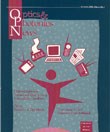Feature Articles
Overcoming the Last Communications Bottleneck
Exposed as we are to a torrent of victory bulletins from the front lines of R&D labs and marketers, it is easy to believe that the information revolution is being won. Computers get faster, smaller, and cheaper. Fiber optics technology adds enormous capacity and diversity to telecommunications. Television becomes sharper in picture and global in reach. Fax, VCRs, PCs, and laser printers reach distant cottages. Thus, humankind appears to be on the verge of achieving mastery over information, turning the scarcest of all resources— knowledge—into an abundant one. Yet at the same time we seem, in our private and professional lives, to become less the masters of information and more its slaves, forever trying to catch up with the torrents that reach us and usually failing. Why is this happening in the face of the marvels of new technology?
by Eli M. NoamSome Light Reading for the Optical Engineer
The engineer who does not follow the literature does him or herself a disservice, as well as doing one for his employer. There is much gold to be mined in the journal literature. The problem for the engineer is primarily one of the extraction and refining techniques to be used in obtaining the information.
by R. R. ShannonFor Want of a Standard, Hours Can Be Lost
Last month this column was written on board the French TGV train. This month I want to follow up with another train story from the same trip to illustrate some of the problems that arise with standards when we cannot anticipate future events.
by Robert E. ParksOnly the Shadow Knows
When I was a youngster, I was taught that light goes in straight lines. At some point, I also became aware that light spreads out from a light source such as a light bulb. However, it still seemed to me that I was missing something important. I couldn't figure out why shadows had such blurry edges. If the light goes straight, shouldn't the edge of a shadow be sharp? And what really bothered me was, if the light spreads out—gets bigger in a sense—and we use our pupil to grab a tiny fraction of that light, why can we see the whole object?
by Janet ShieldsUndersea Lightwave Transmission Systems Using Er-doped Fiber Amplifiers
The erbium-doped fiber amplifier (EDFA), a research curiosity in the late 1980s, will be the backbone of future undersea lightwave communications by the mid-1990s. Erbium-doped fiber amplifiers will have a profound impact on the design, operation, and performance of transoceanic cable transmission systems. The first amplifier systems to be installed in the mid-1990s will increase the capacity of undersea systems four-to-eight fold over the most advanced digital fiber system in use today. Later generations of erbium-doped fiber amplifier systems promise to satisfy the international transmission needs into the 21st century.
by Neal S. Bergano


![A multiplexed image of a human tonsil acquired. [NIAID] using the iterative bleaching extends multiplexity (IBEX) method.](https://opnmedia.blob.core.windows.net/$web/opn/media/images/articles/2024/0424/departments/202404-cover-web.jpg?ext=.jpg)
